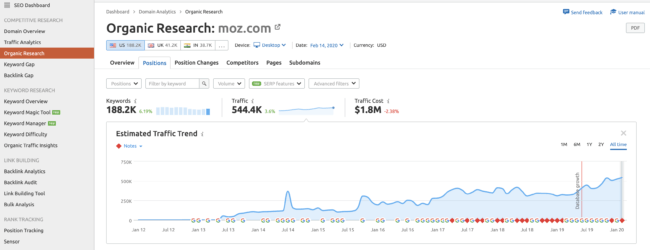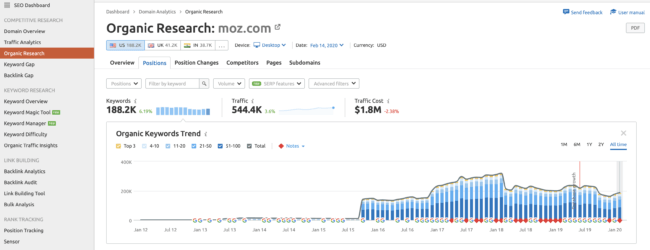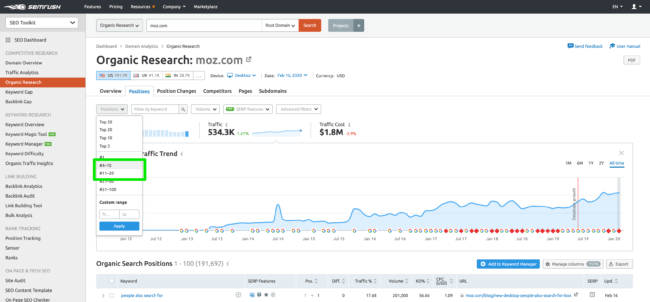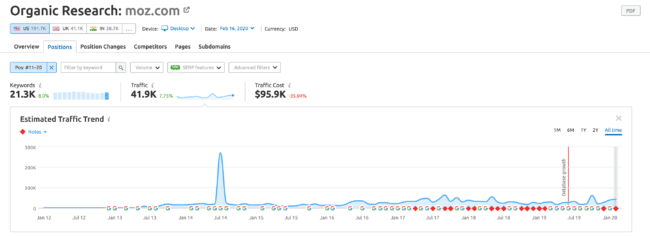Let’s face it – there is a LOT of information on the internet about SEO and how to do very tactical things like building new links, fixing information architecture, writing proper title tags, doing an SEO audit, and the like.
There’s a lot of information about how to do SEO, but there is woefully little out there about measuring SEO and knowing if you’re getting a return. When you Google [seo metrics] (and find an article other than this one) it’s likely about metrics that SEOs themselves care about.
This is a problem, and here’s why.
A recent conversation I had with someone looking to hire went like this:
Me: So, what results are you seeing from your current firm?
Them: Well, they did an audit, built some links, and they’ve producing 4 blog posts a month.
Me: Sounds like it could be a pretty good holistic SEO program. What sort of results are you seeing?
Them: Well, our Domain Authority hasn’t moved.
Me: What about traffic, leads, conversions? What have those done?
Them: Well, our last SEO agency kept our Analytics and this one hasn’t set it up yet, so we don’t know.
Me: 😳
These conversations, to put it nicely, frustrate me. They frustrate me because SEO is such a major part of online business and yet so many businesses aren’t measuring the impact and thus are under-investing in it.
For businesses working with firms, this is a problem for you because you have problems showing the ROI of SEO to your bosses and continuing to justify the spend. Executives then latch onto some nebulous metric and ask you about that and you’re left talking about a specific metric that doesn’t matter when all of the business impact you’re driving is ignored.
For firms or consultants working with clients, this is a problem because your ability to drive results is influenced by the budget you have to do the activities that affect the business metrics. For too long, SEO firms have reported on metrics like “links built” or “Domain Authority”, when those don’t drive the business and don’t show the positive business impact your work is having. Without knowing or showing that impact, budgets won’t increase and impact therefore won’t increase. And all too often, you lose the client even when great work and business results have been achieved.
So let’s stop that. Today, right here and right now, I want both sides to commit to measuring the metrics that matter to business growth. Whether that is leads (that then turn into clients) or revenue, measuring this is ultimately what keeps everyone in a job and keeps businesses growing.
Table of Contents
Business SEO metrics vs SEO practitioner metrics
Before we get further into this diatribe, let’s first differentiate between business SEO metrics and metrics that SEO practitioners should track (or at minimum know where to find).
Business SEO metrics are the numbers that you report to executives. These are simple – they’re the metrics that executives are accountable towards for company performance and the metrics that help them make strategic decisions about where to invest in the future.
SEO practitioner metrics are the numbers that those driving SEO performance should be measuring, watching, and optimizing to affect the business SEO metrics.
Business SEO metrics are reported to clients and executives to show the value of your work to their business.
SEO practitioner metrics help SEOs drive SEO strategy to get the numbers to then report to executives. Of course, if it’s an in-house SEO team then you may be discussing the SEO practitioner metrics to them.
4 SEO business metrics that matter (and a few that don’t)
First, let’s talk about the SEO business metrics that matter when reporting to clients to show them the impact of your work.
These are:
- Year on year organic traffic improvement
- Keyword count improvements
- Revenue/leads from organic
- Competitive market share
Before we get into them, I must clarify one thing. Just reporting on one of these by itself isn’t going to give an honest picture of the return that SEO is giving you.
Let me also be very clear that I am not saying that someone not reporting on all of these is being dishonest purposefully. We’re all works in progress, and as long as we’re getting better every day and striving do better then that is what matters.
Organic traffic improvement
Professional SEOs like to say all day “Well, it’s not just organic traffic that matters, but qualified organic traffic.”
Let’s move beyond that head-fake and accept that this is true (because, well, it is).
But the truth is this – when investing in SEO, without traffic improvements/increases of some sort you are not going to see your business metrics move.
Why?
Because SEO is focused on acquiring more traffic, full stop. Once you move beyond acquiring more traffic, it ceases to be SEO.
SEO is not CRO is not content marketing…you get the idea.
If you’re investing in SEO, whether that be technical, content targeting new keywords, or linking building, the lesson is clear:
Organic traffic improvements matter.
The easiest way to find this for a site other than yours is via SEMrush on the Organic Traffic report found at a URL like:
https://www.semrush.com/analytics/organic/positions/?searchType=domain&q=moz.com (just swap out your domain to replace moz.com).

To find your own organic traffic, of course the source of truth is your own Analytics software (likely Google Analytics). If you want to get really geeky, then pull it from your server logs.
Keyword count (and improvement)
Next up is organic keyword count. This is easily benchmarked and tracked via a tool like SEMrush (use that link for a free 30 day trial) by navigating to a domain’s Keyword report at a URL like:
https://www.semrush.com/analytics/organic/positions/?searchType=domain&q=moz.com (swap out your domain for moz.com)

Just the Keyword Count and Estimated Organic Traffic reports shown here underscores the importance of reporting on multiple metrics.
In Moz’s case, it seems be that their raw number of ranking keywords has declined by approximately 40% its high in February 2018, but their estimated organic traffic is UP by about 20%! So they’re ranking for fewer keywords, but have more traffic (and, likely, more trials and customers and therefore revenue).
Revenue/leads
While organic traffic and keyword count are important metrics to look at (and to set proper expectations around), they’re not what makes you money. Even if you are an advertising-supported business, it’s still not traffic that makes you money. It’s the advertising dollars, and traffic feeds that.
This is why it’s important to report on the metrics that then drive the business – revenue / leads / trials / whatever it is that drives your business according to the business model.
This tracking becomes very difficult, I’ll admit. Though, I want to caution you that you should report what you can get because some insight is better than no insight. As long as you’re not tracking the wrong thing and thus getting the wrong insight, you’ll be on a better track to proving out SEO (or whatever channel) investment than if you had nothing.
So how do we start getting this insight?
The most basic is Google Analytics, and while it’s never perfect it is better than nothing.
By setting up goals or ecommerce tracking, you can get insight by channel (and campaign if you’re tagging traffic correctly) to them report on. Over time, you can report on this data over time with month on month or year on year (YoY is usually the better metric because most businesses are seasonal).
If your business runs off leads generated (MQLs), then pipe them into the CRM used by your sales team and make sure that the source is included. Then you can run reports against that CMS to show not only how much revenue your organic efforts added but also how that organic traffic compares for qualified leads as compared to other channels.
Market share
Wikipedia defines market share as:
Market share is the percentage of a market (defined in terms of either units or revenue) accounted for by a specific entity.
When thinking about SEO, I think of market share as search visibility share. How is your organic performance doing against that of your competitors?
Of course you can’t get their analytics data like you can get your own, so the best way to do this is to once again use a tool like SEMrush to gather their data and compare it against your own.
I like to report on:
- Estimated traffic
- Keyword count
- Backlinks (root domains and number of links)
- Percentage of top 10 rankings for main keywords
SEO “business metrics” that don’t matter
Now let’s talk about the metrics that don’t matter as a stand-alone metric themselves.
Agencies/consultants may hear these requested by their client, and in-house SEOs may hear these requested by their boss/superiors.
These include:
- Domain Authority
- Number of links built
- Pieces of content published
Here’s why.
Domain Authority
Domain Authority is a number created by the good folks at Moz as an alternative to Google’s own PageRank/Toolbar PageRank. PageRank is Google’s internal way of measuring websites (TBPR was a 1-10 scale) whereas Domain Authority is Moz’s 0-100 metric. This number moves with the rest of the internet as Moz recrawls the web to find new links.
While a good directional metric, the way DA works means that your Domain Authority can go down even when you’ve been building links simply because the rest of the internet (not just your competitors!) built more than you did.
What really matters is how you are doing compared to your competitors, and even then Domain Authority doesn’t really map to how well the site is doing in search.
There are much better metrics.
Number of links built
Some executives want to know how many links you built in that month, as if raw number of links built leads to SEO success. The reality is that it’s links built to pages that improve in rankings and drive more qualified traffic and therefore revenue that matter.
If someone doesn’t know SEO well, then they might ask “well, how many links did you build?” or “How many links do our competitors have?”
As an SEO, you’ve almost definitely heard these questions (or slight variations on them) before. And you’ve probably tried to explain why this number in and of itself isn’t the right one to be asking about, and you’ve probably been frustrated when your client or boss then said “Yes, but how many links?”
I like to approach this question like chocolate broccoli.
Executives who know a bit about SEO know enough to ask about links. What they think they want is links. That’s the chocolate. As someone with a sweet tooth, my body thinks it needs chocolate. That’s not true – it needs broccoli.
Note: I am not saying that you don’t need links to rank. You absolutely do.

Broccoli on the other hand is good for you. It’s what your body actually needs, but you might not actually want it (or know you want it).
So what do you say when an executive asks how many links you’ve built or how many links you have as compared to your competitors?
I say tell them, but put it in context. If you’ve been focused on technical SEO cleanup and haven’t been building links because of lack of budget and time, tell them that and then ask for that budget.
Just don’t report links as a metric in and of themselves, especially when link tracking tools can miss links or leave links in their index that aren’t actually there anymore. Like DA, number of links existing or built are directional metrics at best and need to point to the larger picture – revenue.
Pieces of content published
If you’re doing SEO for clients or in-house you’re likely producing content for two reasons:
- To rank and drive qualified traffic;
- To build links back to your site to accelerate point 1 above.
And since you’ve investing in creating content, your executives/clients might want to know how many pieces of content were produced or will be produced for that budget.
Once again, chocolate broccoli.
They think they want more content. Raise your hand if you’ve ever heard “$700 for a blog post?! I can get blogs produced for $50 in India!”
Follow my lead – 🙋♂️
And they’re probably right – they can get bad content written for cheap. But if they want good in-depth well-researched content that will actually rank and drive customers and attract links (coupled with outreach), then you have to pony up the cash.
But the point still stands – to increase your keyword count (remember the second point in metrics that matter?) you need to create content and then rank that content.
You’re giving them chocolate by doing what needs to be done – producing content within the budget that you have.
But you also need to give them the broccoli of traffic / leads / revenue, which all map back to the metrics that matter above.
One thing you can also try is showing them how content that you invest in (big content guides etc) outperforms smaller content you might also be doing. And by outperforms I mean according to the metrics that matter – traffic, revenue, etc.
Point is, we have to go deeper than raw “We published 17 pieces of content this month” and actually show them why it matters.
5 SEO practitioner metrics that matter
Now let’s talk about SEO practitioner metrics that matter.
As stated the very top of this article, these are metrics that professional SEOs, whether in-house or delivering SEO services to clients on an ongoing basis, should be monitoring because they inform their strategies and activities driving organic performance forward.
However, these are not key metrics to report to clients without context (are you seeing the broader point here? Specific metrics alone are never enough!) because they have the very real potential to derail conversations and strategies.
SEO practitioner metrics that matter
Here are some of the metrics that, in our opinion, professional SEOs should be monitoring.
Keyword visibility and opportunities
We talked at the top about Keyword Count as potentially a metric that you report to clients, as this maps to overall organic performance because all of the activities of an SEO campaign (technical, content, and links) all move this metric forward (and when you’re purposefully doing something to reduce that number, it’s important to set those expectations internally).
So while we care about keyword count, what I think professional SEOs should care about more is opportunity keywords that are not yet ranking.
What do I mean by that?
I mean keywords that are not yet driving substantial traffic but could be if you can:
- Move keywords ranking 4-10 to 1-3;
- Move keywords ranking 11-20 to 4-10.
Here’s an example of how to do this within SEMrush.
- Navigate to your site’s SEMrush dashboard at https://www.semrush.com/info/SITE.com;
- Click Keywords in the top middle of the screen;
- Use the dropdown as seen below to see these keywords.

You’ll see your graph change:

This knowledge then serves you in two ways:
- Identifying low hanging fruit keywords that you can target via new content or better optimization of existing assets;
- Understanding how your efforts are driving value that has not yet been realized through page 1 rankings, which informs your future strategies.
Site technical errors
Up next is technical site errors. You might not believe the number of “SEO proposals” I see that are basically a list of technical errors that are then pitching ongoing SEO services. (Reality: those proposals don’t get signed.)
But, as an SEO professional you should be monitoring your site’s errors. Every site has a few errors at any time, but of course if the site or company is constantly being updated or developed then these grow over time.
You should monitor these so that you can understand when new errors appear, and also when errors that weren’t worth the development time before have become large enough to merit that investment.
Link velocity and toxicity
While we talked above about why raw numbers of links and links acquired is a bad metric for both service businesses and clients, link velocity and toxicity are important to monitor so that you can understand how well your efforts are performing and when you may have hooked a troll or an unethical competitor.
I do this using SEMrush’s Backlink Audit tool, available in your SEMrush subscription. They both send emails as well as providing you the raw list for review (and make it easy to disavow these bad links).

Link opportunities
Along with the above comes link opportunities. Often these come up because of competitor monitoring (using a tool like SEMrush’s Backlink Gap tool) and learning where competitors are getting their links.
While you don’t just want to copy a competitor’s link campaigns, their campaigns do give you good insight into opportunities for your own site/company. And getting links from the same places they are isn’t a bad approach – it’s just not a full and optimal approach.
There you have it – our take on SEO metrics for 2020 for in-house and services practitioners. Which ones do you also use?
Start a conversation in the comments below!

